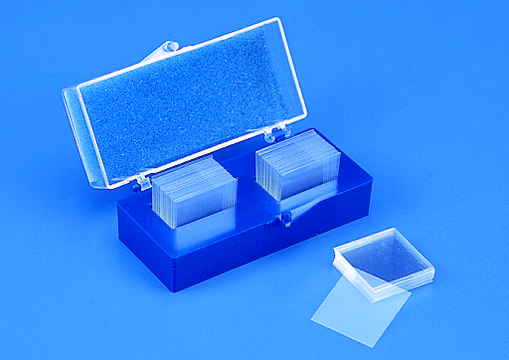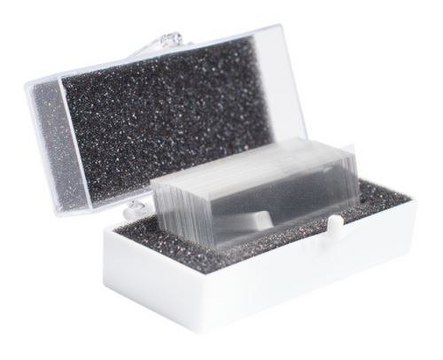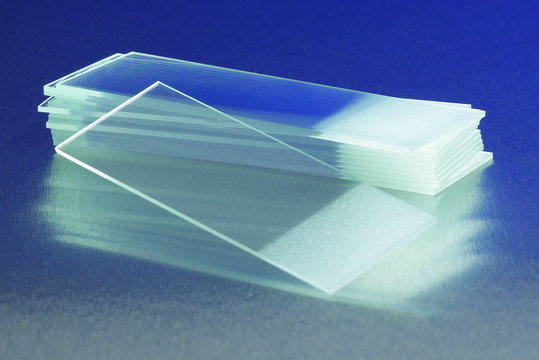643254
Gold coated glass cover slip
L × W × thickness 22 mm × 22 mm × 130-170 μm, square, 99.999% (Au), layer thickness 100 Å
Sign Into View Organizational & Contract Pricing
Select a Size
All Photos(1)
Select a Size
Change View
About This Item
Empirical Formula (Hill Notation):
Au
CAS Number:
Molecular Weight:
196.97
EC Number:
MDL number:
UNSPSC Code:
12352300
PubChem Substance ID:
NACRES:
NA.23
Recommended Products
Assay
99.99% (Ti)
99.999% (Au)
L × W × thickness
22 mm × 22 mm × 130-170 μm, square
layer thickness
100 Å
refractive index
n20/587 1.523
matrix attachment
Titanium, as adhesion layer used to bind the gold to the borosilicate glass cover slip
SMILES string
[Au]
InChI
1S/Au
InChI key
PCHJSUWPFVWCPO-UHFFFAOYSA-N
Looking for similar products? Visit Product Comparison Guide
Related Categories
Features and Benefits
Corning® 0211 zinc titania glass, a particular formulation of borosilicate glass that lends itself very well to being sliced into thin pieces.
The gold surface is highly polycrystalline but shows a tendency towards <111> orientation.
Other Notes
Titanium adhesion layer used to bind the gold to a zinc titania glass cover slip.
Legal Information
Corning is a registered trademark of Corning, Inc.
Storage Class Code
13 - Non Combustible Solids
WGK
nwg
Flash Point(F)
Not applicable
Flash Point(C)
Not applicable
Regulatory Information
新产品
Choose from one of the most recent versions:
Already Own This Product?
Find documentation for the products that you have recently purchased in the Document Library.
Fengxian Zheng et al.
Journal of nanoscience and nanotechnology, 13(6), 3990-3998 (2013-07-19)
Gold nanoparticles (AuNPs) are of biomedical importance, such as delivery vectors. Therefore, we used all-atom molecular dynamic simulations to study the interaction of AuNPs with cell membrane (DMPC bilayer). We observed that the AuNPs adhered spontaneously on the surface of
Claudia Diletto et al.
Journal of nanoscience and nanotechnology, 13(7), 5215-5220 (2013-08-02)
Innovative hybrid nanocomposites based on a nanostructured block copolymer (BCP) matrix whose lamellar nanodomains are selectively loaded with metal nanoparticles, have been prepared. A symmetric poly(styrene-b-methylmethacrylate) (PS-b-PMMA) amorphous BCP showing a lamellar morphology has been employed. Thin films of PS-b-PMMA
Bibek Jyoti Borah et al.
Journal of nanoscience and nanotechnology, 13(7), 5080-5087 (2013-08-02)
Multifunctional phosphine based ligands, 1,1,1-tris(diphenylphosphinomethyl)ethane [CH3C(CH2 PPh2)3][P3] and 1,1,1-tris(diphenylphosphinomethyl)ethane trisulphide [CH3C(CH2P(S)Ph2)3][P3S3] have been introduced to stabilize Au(o)-nanoparticles having small core diameter and narrow size distribution. The Au(o)-nanoparticles were synthesized by the reduction of HAuCl4 precursor with NaBH4 in the presence
Zhengxia Liu et al.
Journal of biomedical nanotechnology, 9(6), 1017-1028 (2013-07-19)
Ischemic stroke is a leading cause of death and disability, and the treatment options are limited. Recent studies demonstrated that the promising applications of gold nanoparticles (Au-NPs) as intrinsic therapeutics; however, little is known about the effect of Au-NPs on
Tae-Sik Cho et al.
Journal of nanoscience and nanotechnology, 13(5), 3711-3714 (2013-07-19)
The crystallization of Au/glass ultrathin films for surface plasmon resonance (SPR) biosensor has been studied using synchrotron X-ray scattering and field emission scanning electron microscope. In films thinner than 30 nm, crystallized Au grains with [111] preferred orientation were formed
Our team of scientists has experience in all areas of research including Life Science, Material Science, Chemical Synthesis, Chromatography, Analytical and many others.
Contact Technical Service




